Blog System/5 hasn’t always been called this way and it hasn’t been my first experience with blogging either. In fact, today marks the 20th anniversary of this publication in its various incarnations so it’s time for a bit of reflection.
Just to set context for when 20 years ago was: Windows XP was almost 3 years old, Ubuntu had just debuted, Apple computers were still PowerPC-based, Half Life 2 was about to launch, and Slashdot was the place to be instead of the yet-to-be-created Hacker News. As for myself, I was still in college, had copious amounts of free time, and was a really active contributor to NetBSD.
So let’s start with a trip down memory lane before getting into the retrospective and the analysis of how my Substack experiment, which started late last year, has turned out. Beware that because this is an introspection post, all of the generalizations that follow are backed by feelings, not hard data, so take them with a grain of salt.
History: Episode one
Looking back at my very first post from June 22nd, 2004—oh wow, my English was bad—I had an earlier experiment of a blog a few months prior that didn’t last more than three entries. But the newer iteration, started during college finals of course, did stick. I originally chose the LiveJournal platform because it had more features than Blogger, and thus “jmmv’s weblog” was born. Why “weblog” and not “blog”? Because the “blog” term wasn’t yet the popular one.
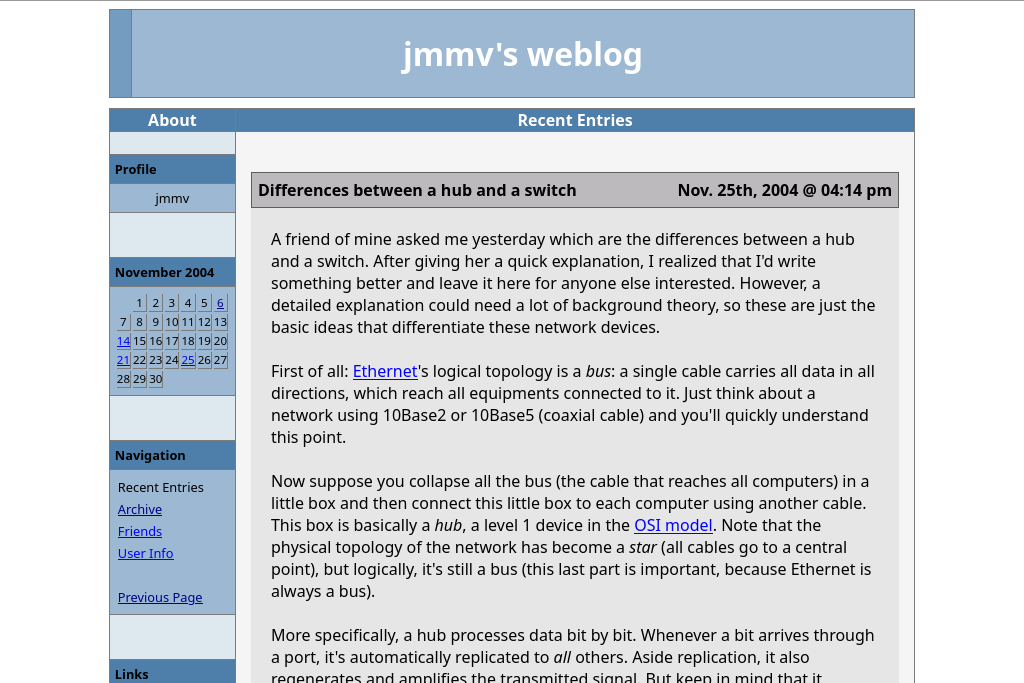
My choice of LiveJournal didn’t last very long though. I migrated to Blogger on October 22nd, 2005 because it had improved significantly by then and it was growing in popularity. As part of that transition, I renamed the blog to “The Julipedia”—a nickname that a friend gave me because I usually had answers to all of his Linux-related questions. And yes, Wikipedia was a pretty new thing back then too, having just launched in 2001 and still being mocked as “the thing that will never compete with real encyclopaedias”. Ha, ha.
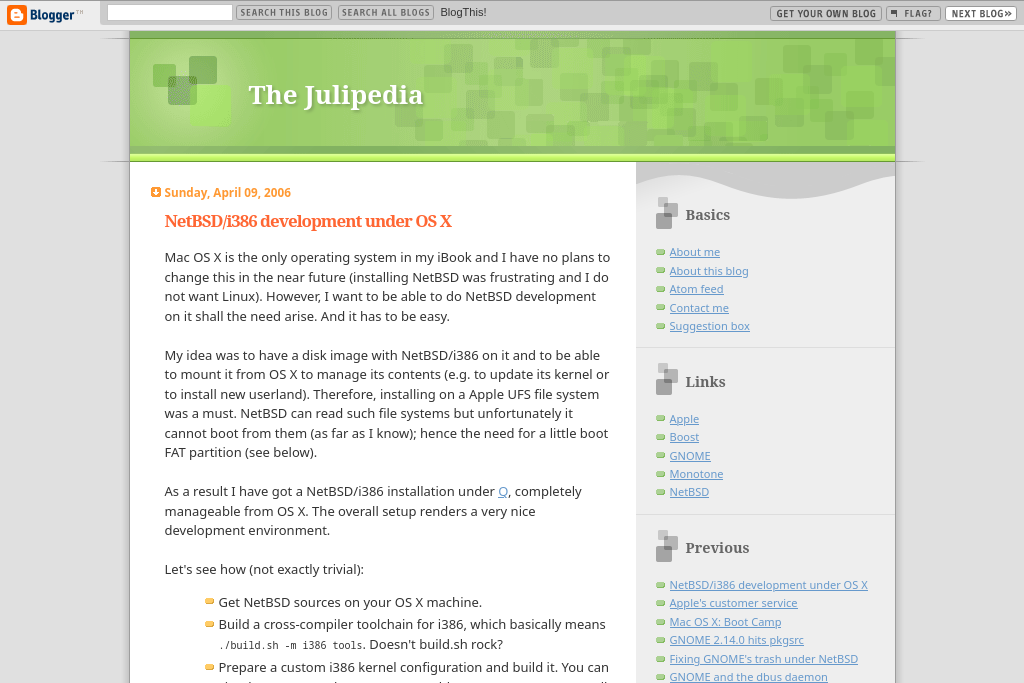
Blogger was just fine for a long time… until Google+ messed things up in 2011 or so. During that era, Google was shoehorning their social platform everywhere, and part of that process was optionally injecting the commenting system of Google+ into Blogger. I took the bait and adopted the new commenting experience—which, in other words, meant that I killed engagement overnight.
In any case, I continued to hold onto Blogger until about 2015. At that point, Medium was the new hot thing and, having grown disillusioned with Blogger’s staleness—the platform didn’t receive any love because all development and product resources had gone into the dwindling Google+—I gave it a try.

Medium was great: its UI was neat and their value proposition was that their network would help me increase the reach of my articles while offering a delightful publishing experience. But things went downhill pretty quickly too: the desire to monetize Medium made it gain aggressive subscription popups and paywalls everywhere, and it started filling up with “Top N things to XYZ” spam. AI-generated garbage? Not yet, but close. Yikes SEO.
History: Episode two
My Medium experiment didn’t last very long. I published 8 posts over the course of 5 months but I knew I had to move elsewhere. Part of this move involved exporting those 8 posts and reimporting them into Blogger, which was easier said than done. Medium offered an “export” feature indeed, which sold me in the first place to try it out, but the content of the export was unusable. It took a lot of effort to clean up the tainted HTML that the platform produced to reimport it anywhere else. And this is when it hit me: I was not in control of my content, which was validated by seeing that Blogger’s export suffered from the same issues.
Which drove me to static hosting. I extended the trivial homepage I already had on the web with a blog section, built with Jekyll first and then with Hugo, and managed my blog in there for about 8 years. I dabbled with going back to a CMS a few times because the authoring experience in Markdown+Git+Hugo isn’t particularly… amenable to posting. But every time I prototyped an alternative, I ended up hitting the same roadblocks around content ownership. I wanted to own the originals in a future-proof format.
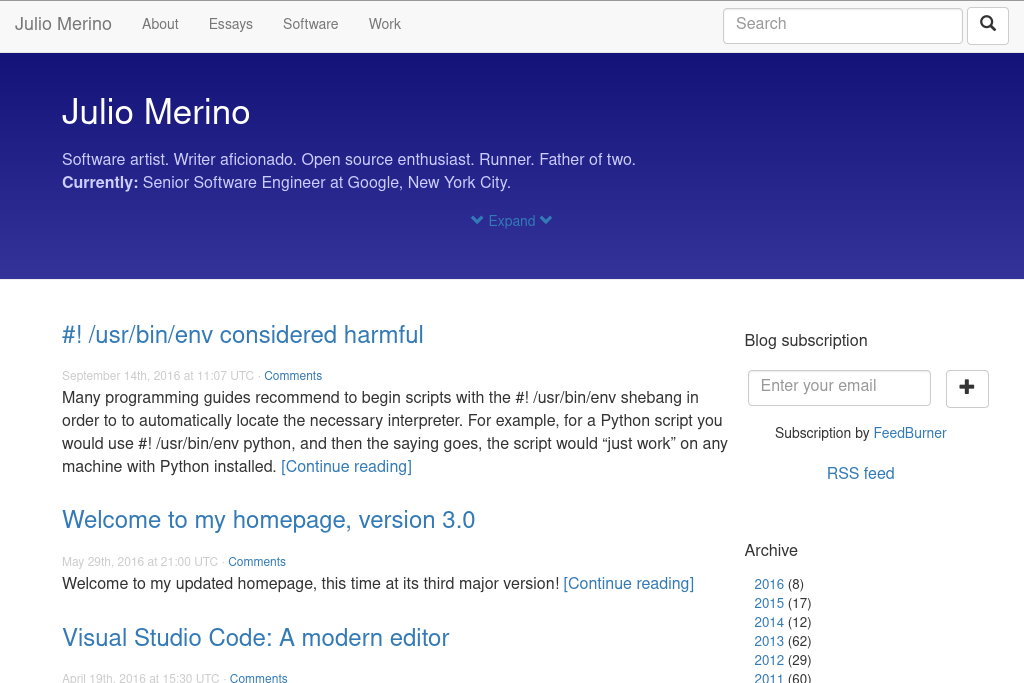
But wait… you are reading this in Substack, aren’t you? “WTH!” you must be thinking. How can I reconcile what I just said with publishing on this platform? Well… over the 8 years of static hosting, it was almost impossible for me to grow my blog’s readership. I tried various things to grow a subscribers base, but nothing worked. And Substack seemed to be the new cool kid on the block where various folks I follow post content, so I had to try it out. This experiment is what brought you Blog System/5 in the first place. And you know what? It has been pretty cool.
The key difference between the Substack experiment and the Medium experiment is that I’m authoring the content in Markdown first, using the exact same platform I had previously set up for my static blog. Only when the posts are ready to publish, I literally copy/paste them into Substack and then set up a redirect in my static blog to point to Substack. It’s painful indeed, but I feel at peace because I can pull the rug at any time and be back in my happy static blog.
Evolution: Writing approach
Anyhow, enough talk about the history of the blog. Let’s talk about how its content has changed form over the years and why it has had to change. And to talk about content changes, we must talk about the evolution of audience behaviors: if you care about being read at all, you must consider who you are writing for.
With that in mind, the obvious question is: do people care about blogs these days? I’d say no, not really. Proof of this is when you hear people say “so and so wrote a blog” (cringe) when they actually mean “a blog post”. The concept of a blog as a personal publication seems to have been lost in favor of individual posts. I’m sure you can think of some recent popular articles that came your way, but, question: can you remember where you read them or who the author was? I bet not.
As a consequence, the type of content for a long-running blog like this one has had to evolve. Take a moment to skim through the archives and look for patterns. You might notice that, back when I started blogging, my usual article was about 350 words long and not very polished. This was pretty common in the blogosphere: most blogs had similar short articles, often just describing the author’s “daily doings”.
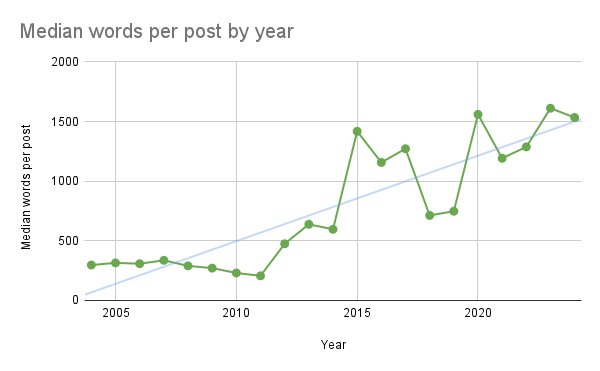
Fast-forward to today and you can clearly see a change in the shape of the articles you read here and elsewhere: they are much longer now, even if attention spans are infinitesimally small. One reason is that we used to use blogs like a social network, to publish our “daily doings” for our committed followers to see. Contrast that to today: there is almost zero chance anyone will come across a bunch of short articles frequently enough for them to become an avid reader. The other reason, closely related to this one, is that it’s easier for long-form posts to “go viral”—and while you might not care about reach, some of us do.
Writing longer-form posts has had a direct inverse consequence on the frequency of the posts though, for obvious reasons:
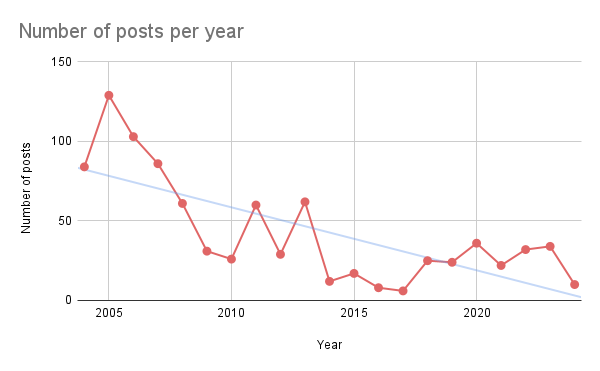
Having to dedicate many, many, many hours to every long-form post necessarily means that the frequency of the articles has to decrease. For this blog, you can clearly see that I started strong with a post about every two or three days and now I consider myself lucky if I am able to average two posts per month per year. I also have much less free time available, so whenever I write an article, I want it to be of higher quality than before.
Fewer articles is not a bad metric per se though. Investing time to write long-form prose is beneficial. Long articles require much more work to put together indeed, but I find that spending such time helps me understand each topic in a better way. Furthermore, one only gets better at writing by, surprise, writing: if you skim through the oldest articles, you’ll notice that they were, ehem, mediocre—yet I made the conscious decision to blog and to do so in English. As a result, I think that my contemporary copy is pretty decent, and this has helped me immensely in my professional environment. I couldn’t have gotten here without going through this long journey.
The other big difference in how the content has evolved is the presence of pictures:
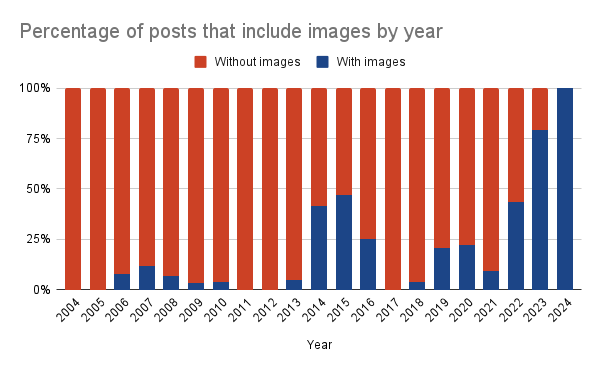
In the past, I rarely included pictures in any article: these were not necessary because the articles were shorter and because resharing articles in social media didn’t require pictures to fight for the small chance of being seen. These days, however, you must have pictures in order to make articles stand out when they are shared. And just due to the nature of the longer text, it’s useful to include pictures, diagrams or code snippets to break the wall of text and make the copy easier to digest. Shout out to draw.io, which has been awesome to create diagrams in some recent posts.
Evolution: Consumption and audience
Shifting gears a little bit, blogs were the true decentralized platform. Any individual could easily start a blog in the service of their choice, possibly self-hosting it if they didn’t want to use a commercial service, and anyone could trivially subscribe to those blogs via one of many RSS aggregators. And, yes, I know, this is true today as well: you can still create a blog and you can still subscribe to (most) blogs via RSS; however, the way blogs are “consumed” has changed.
One thing that was useful in the past were the so-called “Planets”: websites that acted as curated aggregators of blogs by topic. Some of these still exist, such as Planet KDE or Planet Fedora, but they don’t feel like they used to. The longer posts and the (ab)use of images has made Planets unwieldy: their front pages are extremely long and contain lots of irregularly-formatted pictures, offering little content cohesion. Years ago, because articles were shorter, more fit in one page, and because Planets were popular, authors often replied to each other’s controversial interesting thoughts by posting on their platform and seeing their articles bubble up through the Planets. Much like a social media timeline these days but without a central authority.
So, without RSS aggregators or Planets, how do people find blogs now and stay engaged? Well… they don’t for the most part? Organic traffic is pretty much useless at building any kind of following: people come in, read the very few words they were looking for, and vanish right away. Gathering traffic from self-promotion in social media is almost a futile experiment. So the best bet is to have articles turn into “one-off hits” on sites like Hacker News. But even then, the majority of the traffic from those sources ends up being noise as well because it doesn’t lead to conversions into frequent readers. Getting content seen by a reasonable number of people is a fight with every single post.
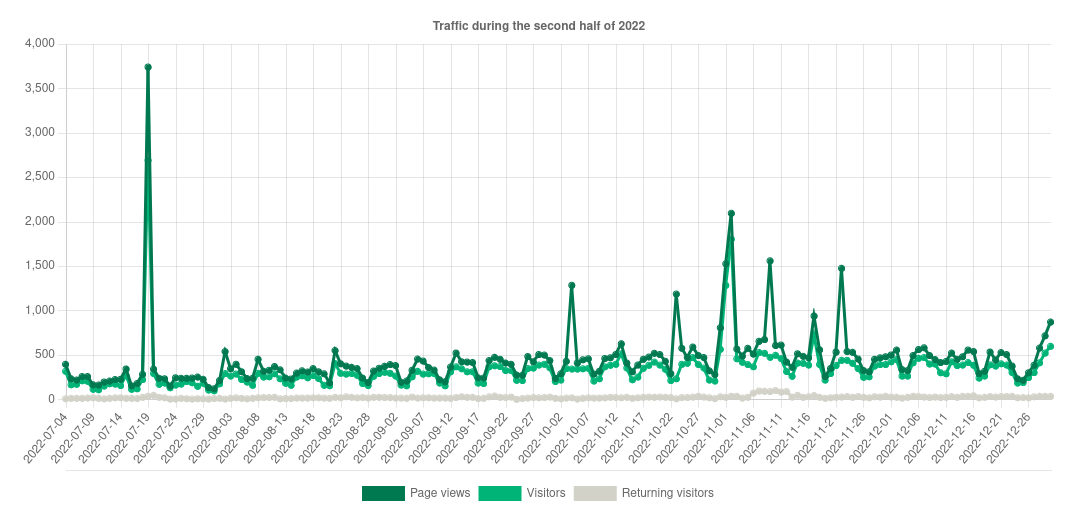
What am I basing this on? Well, for starters, my blog has had email subscriptions for more than 10 years, first powered by FeedBurner and then by my own mechanism. In that period of time, I only saw the subscribers count rise to about 170, which feels pretty pathetic to be honest. I resisted the urge to add “on-your-face” subscription popups, but the lack of those, the fact that some people are “invisible” because of RSS aggregators, and the fact that readers had to subscribe to the blog via obscure platforms… well, there have few incentives to opt into potential email spam.
Now compare this past multi-year effort of a self-hosted blog with custom email subscriptions to what I’ve experienced on Substack since the launch of Blog System/5:
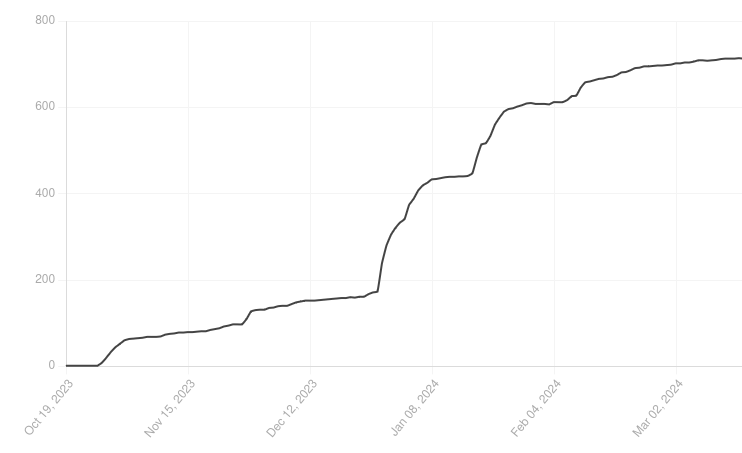
I created Blog System/5 in late October 2023 and by March 2024 I had already amassed 700+ subscribers. It’s also true that I was lucky to have a few articles spread through Hacker News and other sites, and that I put a lot more effort in crafting these than what I wrote in the past, but still: using a platform that people know, that is focused on writing, and in which readers already have accounts helps with growth. Yes, I’m sure there is a lot of fake accounts in there given that the typical “open count” for any article hovers around 50%, but that feels impressive regardless compared to what I was able to achieve in the past.
Evolution: Monetization
And before parting, let’s talk about the taboo topic, should we? Every hobby has to become a side hustle these days, right, but God forbid you try to charge for it.
I have to confess that I’ve dabbled with monetizing my writing and done some experiments. These included: enabling Google AdSense back when I used Blogger and then running away from it; writing paid-for articles for OnLamp, which weren’t really part of this blog originally but were written in the same “spirit”; enabling optional paid subscriptions in Substack, which has generated a handful of leads; and using Amazon affiliate links for certain product-focused articles, which has also generated some sales.
None of these have generated any meaningful amount of income, but that doesn’t mean it isn’t exciting to see pennies flow in! In any case, I still struggle with the thought of pursuing monetization. It’d feel great to be paid for the effort I put in writing, but in the grand scheme of things, I would not be able to make it my primary income—and I’d probably not want it to be either—without putting in a ton more effort. Plus I like my content to reach as far as possible, which paywalls would prevent.
Does that mean I will never try to more aggressively monetize this type of content? Never say never, but I have no plans for now. That said, I will still gladly take and infinitely appreciate any donations you might send; don’t be shy!
From blogging to… newslettering?
Why do I keep writing a blog after 20 years? Because I enjoy the process and the reward of seeing a complete piece be appreciated by many. I know, “views” are a vanity metric, but they do translate into tangible real-world benefits. I’m convinced that I had the chance to land a Google internship in 2008 because of what I wrote in my blog; I’m also pretty certain that my recent job changes have been aided by my writing; and during the last few months, I’ve met some folks I hadn’t seen for a long time and several have exclaimed “hey, I enjoy your blog!” which, let’s be honest, is flattering to hear.
Are blogs truly dead? The answer sounds like “yes”. But what if I asked you if newsletters are truly dead? The answer sounds like “of course not”, right? And, to me, these two look like essentially the same thing. Maybe the differences lie in the fact that blogs used to be made of much shorter posts and used to be part of a larger community, whereas newsletters focus on longer pieces distributed primarily via email… but considering how blogging itself has evolved for some (including me), the two are identical.
Which brings me to the final thought of the day: is “Blog System/5” the same as the “jmmv’s weblog” that launched 20 years ago? No, not really. They are quite different beasts at this point, but they still come from the same—even if older—person, they still scratch the same itch, and they are still my main window to showcase ideas and projects to the outside world. So, to me, they are indeed the same.


